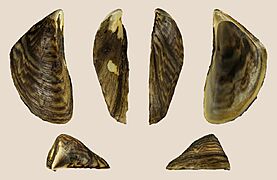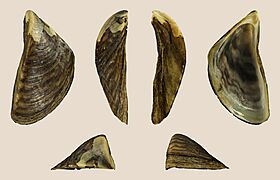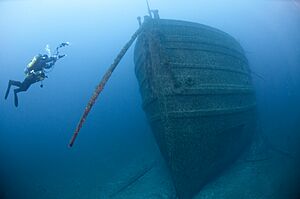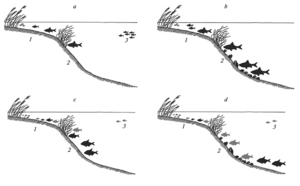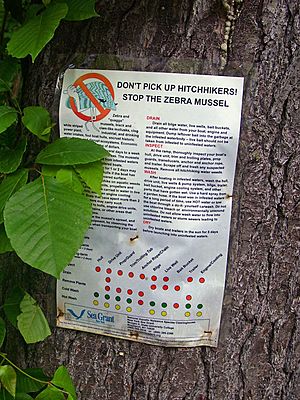Zebra mussel facts for kids
Quick facts for kids Zebra mussel |
|
|---|---|
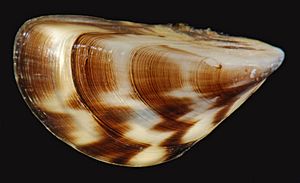 |
|
| Conservation status | |
| Scientific classification | |
| Genus: |
Dreissena
|
| Species: |
polymorpha
|
The zebra mussel (Dreissena polymorpha) is a small freshwater mussel. These tiny creatures originally came from lakes in southern Russia and Ukraine. However, they were accidentally brought to other parts of the world, where they have become a major invasive species. An invasive species is an animal or plant that is not native to an area and causes harm. Since the 1980s, zebra mussels have spread rapidly through North America's Great Lakes and many other rivers and lakes, causing big problems for the environment and for people.
Contents
What Are Zebra Mussels?
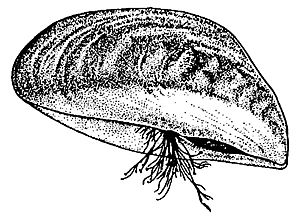
Zebra mussels get their name from the zebra-like stripes often seen on their shells, but not all of them have this pattern. They are very small, usually about the size of a fingernail, and can grow up to 50 mm (2 in) long. Their shells have a unique D-shape.
They attach to surfaces with super-strong threads called byssal fibers. These fibers act like glue, allowing them to stick firmly to rocks, pipes, boats, and even other animals.
Zebra mussels are filter feeders, which means they get their food by filtering tiny particles out of the water. A single zebra mussel can filter up to 1 litre (0.26 US gal; 34 US fl oz) of water every day. Because they filter so much, they can make lake water much clearer.
The Life Cycle of a Zebra Mussel
A zebra mussel can live for about four to five years. They reproduce very quickly. A single female can lay over one million eggs in a year!
These eggs hatch into tiny, free-swimming larvae called veligers. You can only see veligers with a microscope. They float in the water for a few weeks before finding a hard surface to attach to, where they will grow into adult mussels. Adult zebra mussels are tough and can survive out of water for several days if it's cool and damp.
An Unwanted Visitor: The Zebra Mussel Invasion
Zebra mussels are native to the Black and Caspian Seas in Eurasia. But they have spread to many other places, including North America and Western Europe, becoming a major invasive species. They cause problems by taking over ecosystems and damaging human-made structures.
How Did They Spread to North America?
Zebra mussels were first found in the Great Lakes in 1988. Scientists believe they arrived in the ballast water of large ships that traveled from Europe. Ballast water is water that ships carry to stay stable. When the ships released this water in the Great Lakes, the tiny mussel larvae were released too. From there, they spread to other lakes and rivers on boats, trailers, and other equipment that wasn't cleaned properly.
A Widespread Problem
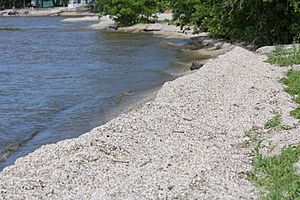
Today, zebra mussels are found in hundreds of lakes and rivers across North America, from the St. Lawrence Seaway in Canada to Texas and California in the United States.
In 2021, they were even found in marimo moss balls, a popular plant for home aquariums. This discovery led to a nationwide recall to stop them from accidentally getting into new waterways from people's homes.
What Problems Do Zebra Mussels Cause?
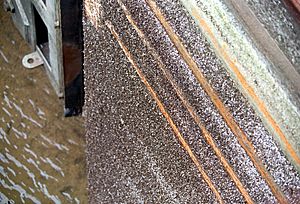
Zebra mussels cause many problems for both the environment and people.
- Clogging Pipes: They grow in thick layers inside pipes, blocking the flow of water to cities and power plants. It costs millions of dollars each year to clean them out.
- Harming Native Wildlife: They attach to native mussels, often in such large numbers that the native mussels can't eat or move, and eventually die. This has nearly wiped out some native mussel species.
- Damaging Boats and Docks: They cover the bottoms of boats, docks, and anchors with their sharp shells. Their shells can also wash up on beaches, making it painful to walk barefoot.
- Changing the Food Web: By filtering so much of the water, they remove food that small fish and other native species need to survive. This can upset the entire ecosystem.
Impact on the Environment
While zebra mussels cause a lot of harm, their effects on the environment can be complicated.
The main problem is that they out-compete native species for food and space. They are also linked to outbreaks of avian botulism, a disease that has killed thousands of birds in the Great Lakes region.
On the other hand, by making the water clearer, they allow more sunlight to reach the bottom of lakes. This helps underwater plants grow, which can provide shelter for some small fish. The clearer water has also helped fish that hunt by sight, like the smallmouth bass. However, these small benefits do not outweigh the major damage they cause to the overall ecosystem.
Predators and Control Efforts
In their native home in Europe, many types of birds and fish eat zebra mussels, which helps keep their numbers in check. In North America, some fish, birds, and crayfish do eat them, but not enough to control their massive populations.
Scientists and conservation workers are trying different methods to control them, such as using special chemicals that only target mussels or physically scraping them off pipes and structures. However, once they are established in a large lake, it is almost impossible to get rid of them completely.
How You Can Help Stop the Spread
The best way to fight zebra mussels is to prevent them from spreading to new lakes and rivers. Anyone who uses a boat or other water equipment can help.
- Clean: After leaving a body of water, inspect your boat, trailer, and anything else that got wet. Remove all plants, mud, and animals.
- Drain: Drain all water from your boat, including the engine, live wells, and bait buckets.
- Dry: Let your boat and equipment dry completely in the sun for at least five days before putting it in a new body of water. Adult mussels can survive for days out of water.
- Aquarium Owners: Never dump aquarium water, plants, or animals into local waterways. If you find zebra mussels in your aquarium, follow official guidelines to safely dispose of them to protect the environment.
Images for kids
-
A current meter from Lake Michigan covered in zebra mussels.
See also
 In Spanish: Mejillón cebra para niños
In Spanish: Mejillón cebra para niños



